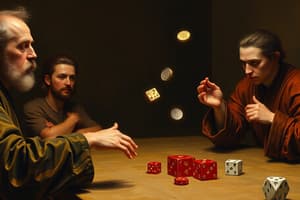Podcast
Questions and Answers
What type of probability is based on equally-likely events and is objective?
What type of probability is based on equally-likely events and is objective?
- Subjective Probability
- Personal Probability
- Quantitative Probability
- Objective Probability (correct)
In basic probability, events that cannot occur simultaneously are known as:
In basic probability, events that cannot occur simultaneously are known as:
- Independent Events
- Collectively Exhaustive Events
- Mutually Exclusive Events (correct)
- Complementary Events
When tossing a coin and rolling a die, finding the probability that the die shows an odd number and the coin shows a head involves which type of probability?
When tossing a coin and rolling a die, finding the probability that the die shows an odd number and the coin shows a head involves which type of probability?
- Bayesian Theorem
- Marginal Probability
- Joint Probability (correct)
- Conditional Probability
If two dice are rolled, what is the probability that the sum is greater than 12?
If two dice are rolled, what is the probability that the sum is greater than 12?
What type of probability is based on personal beliefs, experiences, and intuition?
What type of probability is based on personal beliefs, experiences, and intuition?
In a standard deck of cards, what is the probability of drawing a red card and a diamond at the same time?
In a standard deck of cards, what is the probability of drawing a red card and a diamond at the same time?
What does the 'fair' assumption refer to?
What does the 'fair' assumption refer to?
Which type of probability focuses on the occurrence of an event without any conditions?
Which type of probability focuses on the occurrence of an event without any conditions?
What does the Bayesian Theorem help incorporate as additional information becomes available?
What does the Bayesian Theorem help incorporate as additional information becomes available?
In the context of probability, what does P(A|B) represent?
In the context of probability, what does P(A|B) represent?
In a sample where there are 2 girls, what is the probability of having at least one girl?
In a sample where there are 2 girls, what is the probability of having at least one girl?
If P(B|A) = P(1 Girl | 2 Girls), what does this represent in the given context?
If P(B|A) = P(1 Girl | 2 Girls), what does this represent in the given context?
What is the probability of rolling an odd number on a six-sided die?
What is the probability of rolling an odd number on a six-sided die?
If a fair coin is tossed, what is the probability of getting tails?
If a fair coin is tossed, what is the probability of getting tails?
From a deck of cards, what is the probability of drawing a face card (Jack, Queen, King)?
From a deck of cards, what is the probability of drawing a face card (Jack, Queen, King)?
If there are 5 red marbles and 3 green marbles in a jar, what is the probability of drawing a red marble?
If there are 5 red marbles and 3 green marbles in a jar, what is the probability of drawing a red marble?
What is the probability of getting a black King from a standard deck of cards?
What is the probability of getting a black King from a standard deck of cards?
If you roll a die and toss a coin, what is the probability of getting an even number on the die or a head on the coin?
If you roll a die and toss a coin, what is the probability of getting an even number on the die or a head on the coin?
Flashcards are hidden until you start studying
Study Notes
Types of Probability
- Classical Probability: based on equally-likely events, objective
- Subjective Probability: based on personal beliefs, experiences, and intuition
Independent Events
- Events that cannot occur simultaneously are known as mutually exclusive events
Compound Probability
- Finding the probability of two or more events occurring together (e.g., tossing a coin and rolling a die)
Probability of Specific Events
- Two Dice Rolled: probability of sum greater than 12 is 1/12
- Coin Toss: probability of getting tails is 1/2
- Drawing a Card: probability of drawing a red card and a diamond at the same time is 1/26
- Face Card: probability of drawing a face card (Jack, Queen, King) is 3/13
- Marbles: probability of drawing a red marble from a jar with 5 red and 3 green marbles is 5/8
- Black King: probability of getting a black King from a standard deck of cards is 2/52
Conditional Probability
- Formula: P(A|B) represents the probability of event A occurring given that event B has occurred
- Example: P(B|A) = P(1 Girl | 2 Girls) represents the probability of having 1 girl given that there are 2 girls
Other Probability Concepts
- Fair Assumption: refers to the assumption that all outcomes are equally likely
- Unconditional Probability: focuses on the occurrence of an event without any conditions
- Bayesian Theorem: helps incorporate additional information as it becomes available to update probabilities
Studying That Suits You
Use AI to generate personalized quizzes and flashcards to suit your learning preferences.





